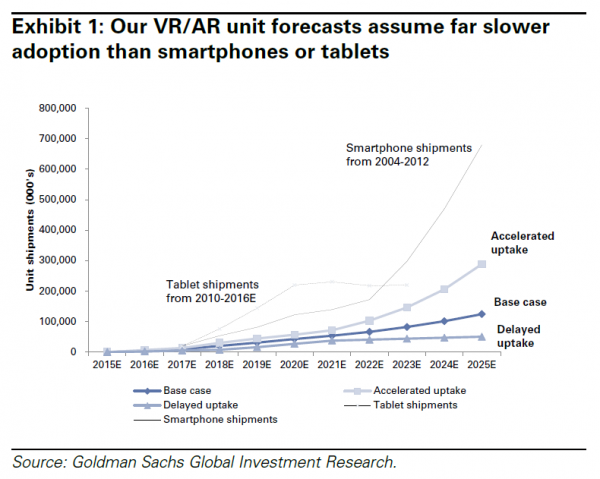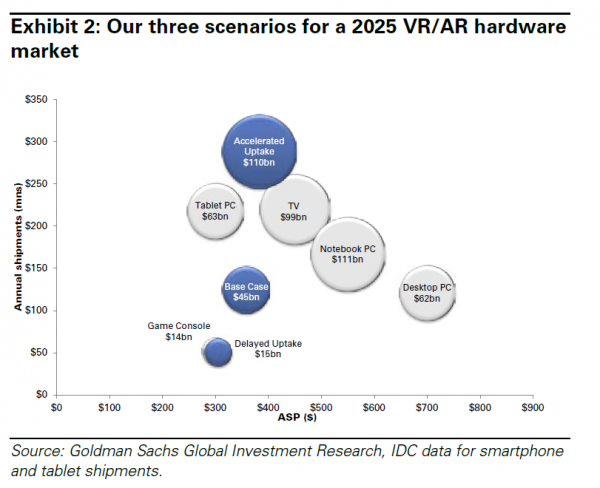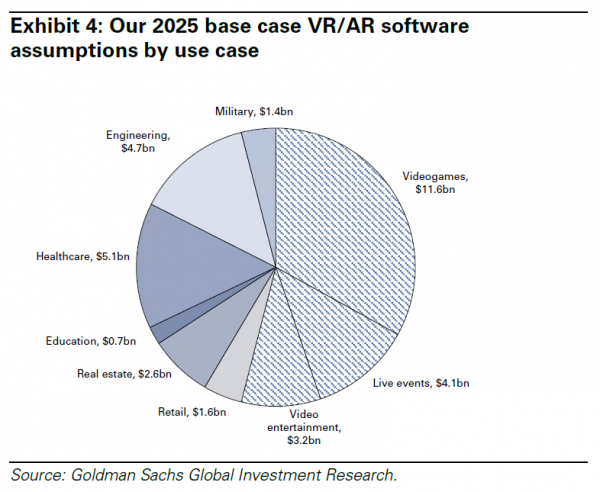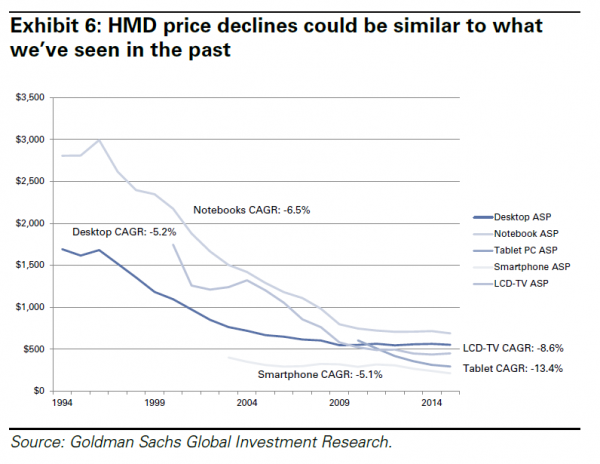[a]listdaily has discussed virtual reality at great length in the past, including the financial boon that will come from the introduction of various headsets this year. However, the team at Goldman Sachs recently published a huge report indicating that it’ll be bigger than anyone imagined – and it could surpass television’s numbers by as soon as 2025.
The report shows that the virtual reality market could reach as much as $80 billion by that time, pointing out several key factors in its success. The highlights from the report can be found below:
Adoption. Even though adoption for virtual reality headsets is likely to be slow at first (mainly due to the cost of around $600, based on Oculus’ selling model), it will ramp up, based on the chart below. It shows just how long it took for smartphone and tablet sales to perk up upon their introduction in the market, with VR headsets showing a similar, but slower, increase.

Accelerated uptake. With the the chart below, accelerated uptake, as the report notes, is expected to be based around numbers, such as “volume adoption framework” and future pricing for models – especially considering that PlayStation VR and HTC’s Vive don’t have finalized pricing just yet. While the base sits around $80 billion, the “accelerated uptake” could go as high as $182 billion.

Usage. While video games will be a primary focus for these virtual reality headsets, Goldman Sachs notes that they can be used for other purposes as well, including entertainment, augmented reality, and even practical uses like health care and real estate. The chart below shows just where these markets break down, and while video games have a whopping $11.6 billion forecast, there are others that will easily find their place, like live events ($4.1 billion) and video entertainment ($3.2 billion). Military, education and health care have a distinctive part of the chart as well.

Price decrease. Some people are balking at the idea of purchasing a virtual reality headset upon release, mainly due to high pricing. However, Goldman Sachs estimates that prices will drop on these head-mounted devices over the next few years, making them affordable. The chart below breaks down just how conveniently priced tablets and smartphones have become since their introduction, even though top-of-the-line models like the iPhone 6S and the iPad Pro continue to command a high price. It just shows there will be balance in the market down the line – although budget-priced items like the Google Cardboard do make virtual reality reasonable to try out.
 Learning from the past. Virtuality arcade machines and Nintendo’s Virtual Boy attempted to make their way into a mainstream market, introducing virtual reality to an awaiting public. However, their failure is noteworthy, and something today’s market can easily learn from.
Learning from the past. Virtuality arcade machines and Nintendo’s Virtual Boy attempted to make their way into a mainstream market, introducing virtual reality to an awaiting public. However, their failure is noteworthy, and something today’s market can easily learn from.
“So what has changed that differentiates the current state from the 1990’s flop?” the company asked. “The answer is the technology, in our view.” It noted that with more powerful computers, better immersion and a relatively cheaper cost for building, there’s a far better chance it will “catch on” this time around.
“Fundamentally, virtual/augmented reality creates a new and even more intuitive way to interact with a computer,” the company noted. “In the world of virtual/augmented reality, the controls of the computer become what we are already familiar with, through gestures and graphics.”
Potential. There are many uses already in mind for virtual reality, and companies are already working on ways for better immersion with it. Microsoft’s HoloLens technology promises to be involving and creative, while Facebook, which purchased the Oculus Rift technology in a whopping $2 billion deal, considers Oculus Rift a “teleporter” tool, according to Business Insider. And that’s a far cry from the weird video games that emerged in the 90’s, with deluxe sized headsets and weird, contained cabinets. There’s more involvement now.
“We continue to believe that VR/AR is poised to be the next computing platform. And like the transition from desktop to mobile, it will be disruptive…” said analyst Ben Schachter, in a note sent out from Macquarie Bank on the report. “The first half of 2016 will see the most significant progress on VR/AR ever.”
He also discussed how more people could be swayed by the technology after trying it out. “We have been fortunate to be in the relatively unique position of having tried the latest versions of almost all known devices,” he explained. “And while each has its pros and cons, it is clear that progress is being made.
Now it’s just a matter of time to see how virtual reality sinks in. One thing’s for sure – it certainly isn’t the Virtual Boy all over again.

